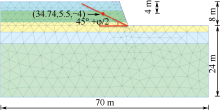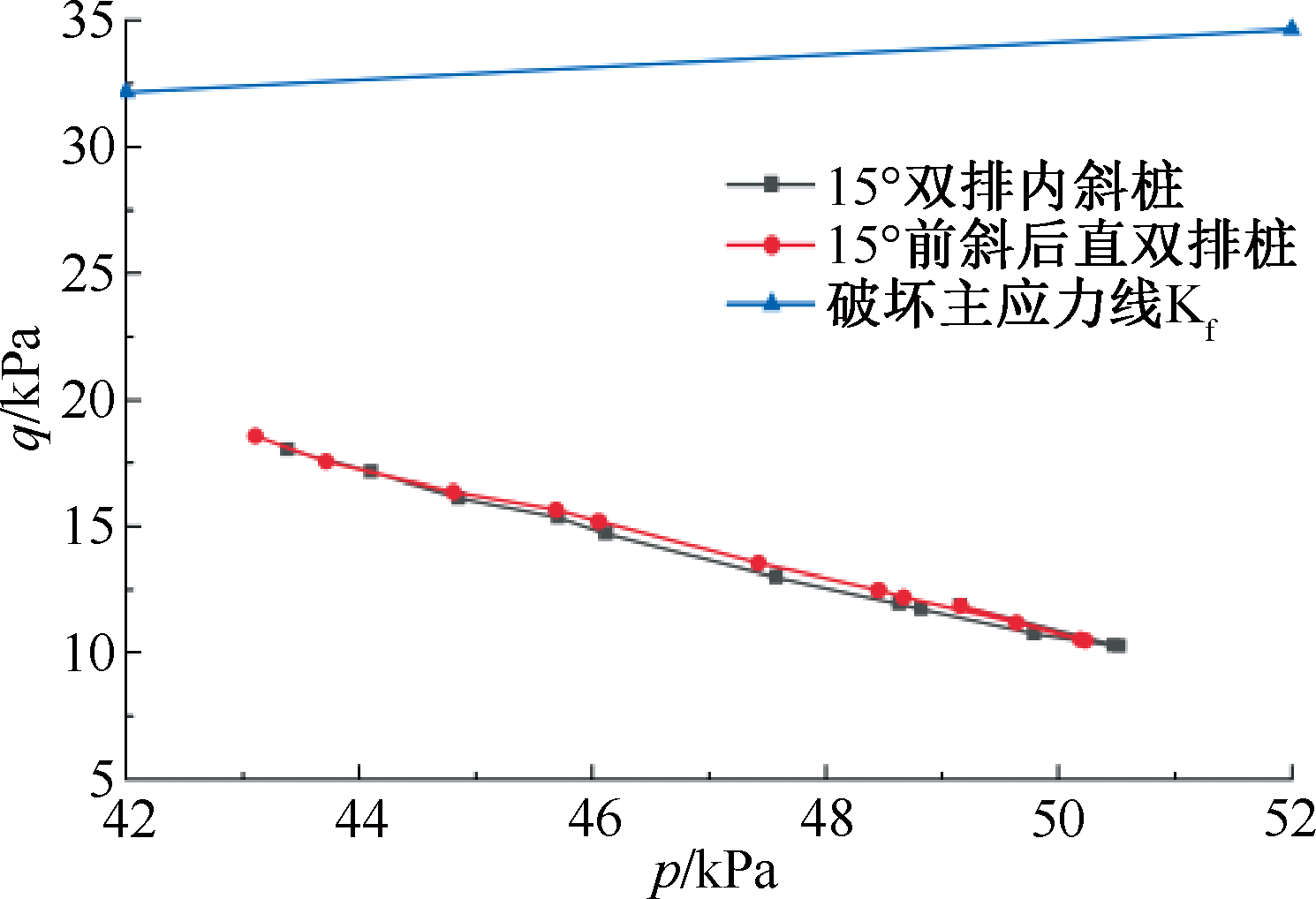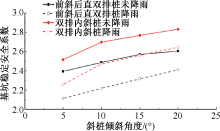| [1] |
张仲宇, 李兆平, 杨航, 等. 并行基坑施工对邻近桥梁影响及保护措施[J]. 中国安全科学学报, 2023, 33(3): 68-74.
doi: 10.16265/j.cnki.issn1003-3033.2023.03.0685
|
|
ZHANG Zhongyu, LI Zhaoping, YANG Hang, et al. Study on influence of parallel foundation pit construction on adjacent bridge and protection measures[J]. China Safety Science Journal, 2023, 33(3): 68-74.
doi: 10.16265/j.cnki.issn1003-3033.2023.03.0685
|
| [2] |
张琦, 王月峰, 李建春, 等. 深基坑紧邻地铁隧道安全评价方法[J]. 中国安全科学学报, 2021, 31(4):95-104.
doi: 10.16265/j.cnki.issn1003-3033.2021.04.013
|
|
ZHANG Qi, WANG Yuefeng, LI Jianchun, et al. Evaluation method for safety of subway tunnels adjacent to deep foundation pits[J]. China Safety Science Journal, 2021, 31(4): 95-104.
doi: 10.16265/j.cnki.issn1003-3033.2021.04.013
|
| [3] |
LAN Binpeng, WANG Yanping, WANG Weiguo. Review of the double-row pile supporting structure and its force and deformation characteristics[J]. Applied Sciences-Basel, 2023, 13(13): DOI: 10.3390/APP13137715.
|
| [4] |
周德泉, 冯晨曦, 肖灿, 等. 倾斜软基上斜直桩组合结构单侧受力破坏模式试验[J]. 中国公路学报, 2021, 34(7): 201-214.
doi: 10.19721/j.cnki.1001-7372.2021.07.016
|
|
ZHOU Dequan, FENG Chenxi, XIAO Can, et al. Experimental study on the failure mode of inclined-straight pile composite structure on declining soft foundation under single side load[J]. China Journal of Highway and Transport, 2021, 34(7): 201-214.
doi: 10.19721/j.cnki.1001-7372.2021.07.016
|
| [5] |
周德泉, 肖灿, 冯晨曦, 等. 侧向堆载下斜桩长度影响斜-直双排桩受力响应试验研究[J]. 公路交通科技, 2021, 38(2): 24-32.
doi: 10.3969/j.issn.1002-0268.2021.02.004
|
|
ZHOU Dequan, XIAO Can, FENG Chenxi, et al. Experimental study on influence of inclined pile length on mechanical response of inclined-straight double-row piles under lateral surcharge[J]. Journal of Highway and Transportation Research and Development, 2021, 38(2): 24-32.
|
| [6] |
周德泉, 曹之烨, 冯晨曦, 等. 倾斜度影响斜-直组合桩单侧受力响应试验研究[J]. 中南大学学报:自然科学版, 2021, 52(7): 2426-2437.
|
|
ZHOU Dequan, CAO Zhiye, FENG Chenxi, et al. Model test on bearing characteristics of inclined-vertical combined pile with varied inclination of inclined piles under single lateral load[J]. Journal of Central South University:Science and Technology, 2021, 52(7): 2426-2437.
|
| [7] |
徐源, 郑刚, 路平. 前排桩倾斜的双排桩在水平荷载下的性状研究[J]. 岩土工程学报, 2010, 32(增1): 93-98.
|
|
XU Yuan, ZHENG Gang, LU Ping. Behaviors of double-row contiguous retaining piles with raking front-row piles under horizontal loads[J]. Chinese Journal of Geotechnical Engineering, 2010, 32(S1): 93-98.
|
| [8] |
叶金铋, 周先齐, 王晨飞, 等. 基坑双排斜桩模型试验研究[J]. 地下空间与工程学报, 2021, 17(2): 398-404,519.
|
|
YE Jinbi, ZHOU Xianqi, WANG Chenfei, et al. Model test of double-row inclined piles in foundation pit[J]. Chinese Journal of Underground Space and Engineering, 2021, 17(2): 398-404,519.
|
| [9] |
田野, 宋志, 张涛, 等. “前斜后直”倾斜桩基坑支护在武汉深厚淤泥质层中的设计与应用[J]. 建筑技术, 2021, 52(11): 1288-1291.
|
|
TIAN Ye, SONG Zhi, ZHANG Tao, et al. Design and application of inclined pile with inclined head and straight body for foundation pit support in deep and thick silt stratum in Wuhan[J]. Building Technology, 2021, 52(11): 1288-1291.
|
| [10] |
田野, 陈国, 宋志, 等. 基坑工程倾斜桩及其与多级支护组合的工程应用研究[J]. 建筑施工, 2021, 43(6): 983-986.
|
|
TIAN Ye, CHEN Guo, SONG Zhi, et al. Engineering application research on inclined pile and its combination with multi-stage support in foundation pit engineering[J]. Architecture Technology, 2021, 43(6): 983-986.
|
| [11] |
JIANG Yuenan, CHEN Runze, SHAO Suola, et al. The behavior and optimization analysis of double-row piles in different forms[J]. Jordan Journal of Civil Engineering, 2022, 16(3): 365-380.
|
| [12] |
YE Jinbi, WANG Chenfei, HUANG Weipeng, et al. Effect of inclination angle on the response of double-row retaining piles: experimental and numerical investigation[J]. Tehnički Vjesnik, 2020, 27(4): 1150-1159.
|
| [13] |
阮从威, 梁鹄, 谭江蜀, 等. 前斜后直双排桩施工技术研究与应用[J]. 建筑机械化, 2023, 44(4): 63-67.
|
|
RUAN Congwei, LIANG Hu, TAN Jiangshu, et al. Research and application of construction technology of front inclined and rear straight double row piles[J]. Construction Mechanization, 2023, 44(4): 63-67.
|
| [14] |
WU Yibin, YE Jinbe, GE Hongbin, et al. Numerical investigation of dual-row batter pile wall in deep excavation[J]. Mechanics of Advanced Materials and Structures, 2022, 29(27): 5793-5807.
doi: 10.1080/15376494.2021.1965268
|
| [15] |
田野, 宋志, 张松波, 等. 武汉长江阶地无支撑倾斜桩基坑支护应用及选型分析[J]. 建筑结构, 2021, 51(增1): 2044-2049.
|
|
TIAN Ye, SONG Zhi, ZHANG Songbo, et al. Application and type selection analysis of unsupported inclined pile foundation pit in Wuhan Yangtze River terrace[J]. Building Structure, 2021, 51(S1): 2044-2049.
|
| [16] |
郑刚, 王玉萍, 程雪松, 等. 软土地区基坑前排倾斜双排桩支护现场试验及工作机理[J]. 长江科学院院报, 2024, 41(6):98-105,113.
doi: 10.11988/ckyyb.20230171
|
|
ZHENG Gang, WANG Yuping, CHENG Xuesong, et al. Field experiment and working mechanism study on the excava-tion retained by inclined double row piles in soft soil area[J]. Journal of Changjiang River Scientific Research Institute, 2024, 41(6):98-105,113.
|
| [17] |
黄传胜, 张家生. 地铁深基坑三维有限元模型尺寸效应分析[J]. 铁道科学与工程学报, 2011, 8(2): 59-63.
|
|
HUANG Chuansheng, ZHANG Jiasheng. Size effect analysis of subway deep foundation pit using three-dimensional finite element model[J]. Journal of Railway Science and Engineering, 2011, 8(2): 59-63.
|
| [18] |
刘涛. 倾斜桩在基坑支护中的作用机理和简化计算方法[D]. 天津: 天津大学, 2018.
|
|
LIU Tao. Mechanism and simplified calculation method of inclined piles in foundation pit support[D]. Tianjin: Tianjin University, 2018.
|































